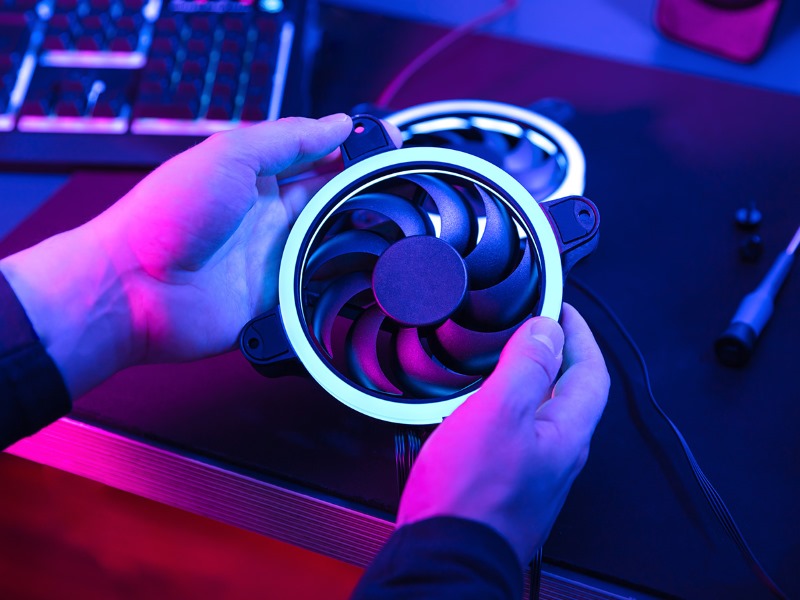It is essential to keep your computer cool if you want to preserve its longevity and performance. The CPU (Central Processing Unit) generates heat while it works, and the CPU fan is there to keep it cool. RPM (Revolutions Per Minute) is a measure of how fast your CPU fan spins. A higher RPM means the fan spins faster, which can help cool your CPU more effectively. But, it can also generate more noise and use more power.
“A CPU fan speed of 4000 RPM is generally okay for basic tasks like browsing or office work. However, it may be too low for gaming or heavy applications. Always monitor your CPU temperature to ensure safe performance.”
In this article, we are going to discuss “Is 4000 RPM Too Low for a CPU Fan”
Table of Contents
What is RPM in a CPU Fan?
RPM, or Revolutions Per Minute, measures how fast something spins, like a CPU fan. A higher RPM means faster spinning, which often helps cool the CPU more effectively.
Higher RPMs move more air, improving cooling and lowering temperatures. Lower RPMs may not provide enough airflow, leading to higher CPU temperatures and potential overheating.
Why Does CPU Fan Speed Matter?

Fan speed and temperature are closely related. Higher fan speeds improve airflow, which helps lower the CPU temperature. Lower fan speeds result in less airflow, leading to higher temperatures and possible overheating. Adjusting fan speed can help manage temperature.
Fan speed impacts PC performance by affecting cooling. Proper cooling helps prevent overheating, ensuring the CPU runs efficiently. If cooling is inadequate, the CPU may throttle performance to avoid damage.
Understanding 4000 RPM for a CPU Fan
When we talk about 4000 RPM, we’re referring to a fan that spins 4000 times in one minute. For many CPU fans, this is a relatively moderate speed. However, whether it’s enough or too low depends on several factors, like the type of CPU you have and what you’re using your computer for.
Factors Influencing the Ideal CPU Fan Speed

Type of CPU and Usage
Different CPUs have different cooling needs. A powerful gaming or workstation CPU might need a faster fan speed compared to a simple office computer. If you’re running demanding software or games, your CPU might generate more heat, requiring a faster fan speed.
Ambient Temperature and Airflow
Ambient temperature and airflow affect your computer’s cooling. High room temperatures can cause overheating, while good airflow helps cool components. Keep your computer in a well-ventilated space to ensure it runs efficiently and avoids heat-related issues.
Size and Design of the CPU Fan
The size and design of the CPU fan are crucial for better cooling. Bigger fans make less noise because they can circulate more air at slower speeds. A well-designed fan improves airflow, helping to keep the CPU cool and prevent overheating.
Is 4000 RPM Too Low for Your CPU Fan?
A fan speed of 4000 RPM is usually enough for light tasks like web browsing or working on documents. For everyday use and moderate tasks, it often provides adequate cooling.
A fan speed of 4000 RPM might be too low for high-demand tasks like gaming or video editing. In these situations, higher speeds may be needed to keep temperatures in check.
Pros and Cons of Running a CPU Fan at 4000 RPM
Advantages of Lower RPM
- Quieter Operation: Lower RPMs often mean less noise, which is great for a quiet work environment.
- Extended Fan Lifespan: Running at lower speeds can reduce wear and tear, extending the fan’s life.
Disadvantages and Potential Risks
- Risk of Overheating: If the fan speed is too low, it may not provide enough cooling, leading to potential overheating.
- Reduced Performance: Overheating can cause the CPU to slow down or even shut down to protect itself.
How to Check Your CPU Fan Speed
To check your CPU fan speed using BIOS settings, restart your computer, enter the BIOS menu (usually by pressing F2 or DEL), and look for the “Hardware Monitor” or “Fan Control” section.
Third-party software tools, like HWMonitor or SpeedFan, let you check and control your CPU fan speed from within your operating system. These tools provide real-time data and customization options.
How to Adjust Your CPU Fan Speed
Restart your computer, go into the BIOS menu, choose the “Fan Control” section, and manually change the fan speed or profile settings.
Software-based fan control methods use programs like MSI Afterburner or Corsair iCUE to adjust fan speeds directly from your operating system. These tools allow for easy and precise fan speed management.
Signs That Your CPU Fan Speed is Too Low

When your CPU fan speed is too low, symptoms may include unexpected shutdowns, system crashes, slow performance, high temperatures, or the computer feeling hot to the touch.
Software glitches, hardware malfunctions, and overheating can all cause system instability and shutdowns. Your computer may freeze, restart without warning, or shut off entirely as a result of this.
How to Improve Cooling Without Increasing RPM
Better Thermal Paste Application
Enhancing the application of thermal paste facilitates better heat transmission from the CPU to the cooler. Apply a little, uniform quantity to the CPU’s center. This ensures efficient cooling, lowers temperatures, and prevents overheating. Avoid using too much paste, as it can cause poor performance and possible damage to components.
Upgrading CPU Cooler
Upgrading your CPU cooler can help lower temperatures, reduce noise, and improve overall performance. A better cooler keeps your CPU from overheating, making your computer more stable and allowing it to handle demanding tasks more efficiently.
Improving Case Airflow
Improving case airflow helps keep your computer cool by allowing hot air to escape and fresh air to enter. Arrange cables neatly, add fans, and ensure vents are clear to prevent overheating and maintain optimal performance for your system.
Common Myths About CPU Fan Speed
- More RPM Always Means Better Cooling: Not always. A well-designed cooler with lower RPM can outperform a poorly designed one with higher RPM.
- Silent Operation Equals Low Performance: A good fan can be quiet and still provide adequate cooling.
Does a High RPM Always Mean Better Cooling?

A high RPM (revolutions per minute) doesn’t always mean better cooling. While it can move more air, factors like fan size, design, and airflow direction also matter. A balanced approach, considering both fan speed and quality, ensures efficient cooling without causing too much noise or using too much power.
When Should You Worry About Your CPU Fan Speed?
You should worry about your CPU fan speed if your computer is overheating, making loud noises, shutting down unexpectedly, or running slower than usual. These signs may mean the fan isn’t cooling properly, and checking the fan speed or cleaning the fan may be necessary to prevent damage.
Conclusion
In conclusion, a CPU fan speed of 4000 RPM is generally sufficient for light tasks but may be too low for demanding activities like gaming. Monitoring your CPU temperature and adjusting fan speed or upgrading your cooling system can help maintain optimal performance and prevent overheating.
FAQs
Is 4000 RPM good for a CPU fan?
It can be good for light tasks, but might be too low for heavy workloads.
How do I check my CPU fan speed?
You can check it in the BIOS or with software tools like HWMonitor or SpeedFan.
Can a low fan speed damage my CPU?
Yes, a low fan speed can lead to inadequate cooling, which might cause your CPU to overheat. Overheating can damage the CPU and reduce its performance and lifespan.
Is it better to have a higher RPM?
A higher RPM can improve cooling by moving more air, but it may also create more noise. Balance between cooling efficiency and noise level is important for optimal performance.
What’s the ideal CPU temperature?
The ideal CPU temperature is typically between 30°C and 60°C (86°F to 140°F). Keeping your CPU within this range helps ensure stable performance and prevents overheating.


